Chess Story The Royal Game first editions by Stefan Zweig
I have built this English page for my German website and I like to promote scientific research to the literature by Stefan Zweig. For a Global cooperation the English language is more suitable than the German. The copyright protection period is usually in the European Union and Switzerland 70 years after the author's death. One should not just add 70 years to the day of death but the public domain begins on 1 January of the year following the 70th year of death of the author. Stefan Zweig, an Austrian writer with a British passport died on 23. February 1942 in his exile in Petrópolis in Brazil. After the expiry of the copyright on 1 January 2013 numerous editions of Stefan Zweig's last novella Schachnovelle were published with the titles in many languages. In some editions this novella is published in an anthology together with other stories by Stefan Zweig. With my remarks on this page I also like to inform book collectors about the rare and early editions of the famous novelette. The main focus is on the first German edition published in Buenos Aires.
Like many other writers in the Third Reich Stefan Zweig and his wife Lotte were forced into exile. First they settled in London and Bath in England and later they moved to Brazil. Since September 1941 they lived in a rented house in the town of Petrópolis near Rio de Janeiro. The small house had a large veranda where Stefan Zweig and Lotte sometimes played chess. This was the place where the chess story was created. On 28 October 1941 Stefan Zweig wrote a letter to his friend and publisher Gottfried Bermann Fischer in which he tells him about the strange thing he has designed and not finished yet, a small novella of about sixty printed pages. In Zweig's opinion it was suitable for a special edition, because the story targets a special circle and rolls up a little bit the philosophy of the game of chess. Stefan Zweig believed that for chess there was another than the literary audience but still a very large circle of players and collectors. To Zweig's knowledge this would be the first serious novella on this subject.
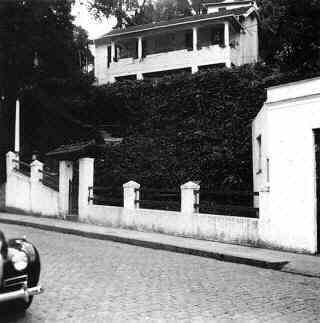
The rented house for Stefan and Lotte Zweig in Petrópolis in Brazil around
1942 © arquivo Casa Stefan Zweig
Lotte Zweig typed the text for the Schachnovelle on a typewriter and used carbon paper for three additional copies. Stefan Zweig made some handwritten notes and corrections and therefore every one of the four typescripts became a bit different. On Friday 20 February 1942 the original typescript was handed over to his friend and publisher Abraham Koogan in Rio de Janeiro. The three carbon copies were shipped by registered postal letter to his publishers Gottfried Bermann Fischer and Ben Huebsch in New York and his translator Alfredo Cahn in Buenos Aires on the day before Stefan and Lotte Zweig committed suicide. But what is the date of Stefan Zweig's death? The English Wikipedia writes Sunday 22 February and the German Wikipedia Monday 23 February. Let us have a look to the death certificate from 24 February: The death occurred on Monday 23 February 1942 at 12:30.
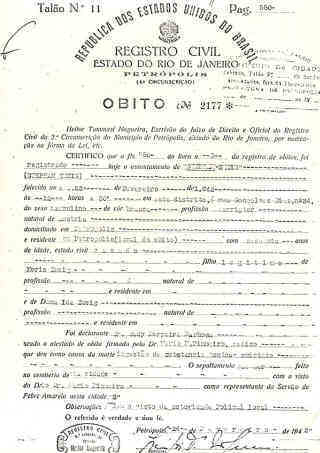
death certificate from 24 February: The death occurred on Monday 23 February
1942 at 12:30 © arquivo Casa Stefan Zweig
All three carbon copies arrived to the addresses by registered letters. This was not always ensured during the Second World War. Not only Stefan Zweig had overworked his own text of Schachnovelle but also in the next step his publishers and translators modified the text. Now the question arises: what is the original? The chronological order of the publication date is here not necessarily determinative.
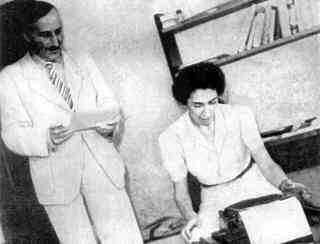
Stefan and Lotte Zweig in their bungalow in Petrópolis around 1940. Lotte
used a portable typewriter manufactured by the American Royal Typewriter
Company. © arquivo Casa Stefan Zweig
The first of the four typescripts received Stefan Zweig's publisher Abraham Koogan in Rio de Janeiro. The first edition of the novella appeared in September 1942 in Brazilian Portuguese, published by Editora Guanabara in Rio de Janeiro. The title is A partida de Xadrez and it is in the omnibus volume As três Paixões (Three passions). Size 22 cm. 213 pp, hardcover, light gray cloth-binding with gold printed title and ornamental gilt spine with printed title.
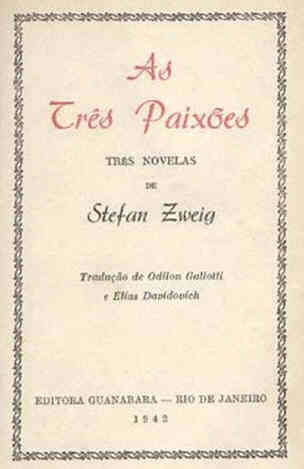
The original first edition of the chess story "Schachnovelle" by Stefan
Zweig in the Brazilian omnibus volume "As três paixões" from September 1942
photo
©
Elke Rehder
The book contains the three novellas A partida de Xadrez (direct translation: The game of chess), Divida tardiamente paga (The Debt Paid Late) and Seria ele? (Did He Do It? ). The translators were Odilon Gallotti (only for the chess story) and Elias Davidovich.
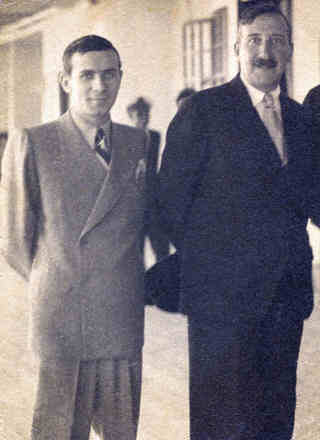
The photo shows the publisher Abraham Koogan together with Stefan Zweig in
1936. The owners of the bookstore and publishing house Guanabara in Rio de
Janeiro were Abraham Koogan (1912-2000) and his brother-in-law Nathan Waissman
(1897-1953). © arquivo Casa Stefan Zweig
The original typescript can be found in the collection of the Reed Library, State University of New York at Fredonia. It was given to the collection by the London-based Stefan Zweig heiress Dr. Eva Alberman.
One of the three carbon copies of the typescript was sent to the address of Stefan Zweig's friend, litarary agent and translator Alfredo Cahn in Buenos Aires. In the accompanying letter from 21 February 1942 Zweig gave Cahn the formal permission to pass the chess story to the journals or publishers and if Zweig can't regulate his own affairs in the future, Cahn should contact his publisher Abraham Koogan in Rio de Janeiro for further specific information. This time Stefan Zweig had not asked Alfredo Cahn to translate the text into Spanish.
After the first edition of the Chess Story which already appeared in September in Brazil, Alfredo Cahn tried to publish the German edition as soon as possible before the German publisher Bermann Fischer could do this. Cahn tried to achieve this in collaboration with the print office of the big company Fabril Financiera together with the book dealer, gallery owner and publisher János Peter Kramer in Buenos Aires. Kramer was willing to offer 50 Roman-numbered copies in cloth binding for sale. A young German immigrant with the name Lili Lebach, who had opened a bookstore with the name Pigmalión just some months ago in July 1942 in Buenos Aires, should be mentioned for the first time as a publisher. She was willing to sell 250 numbered paperback copies for a cheap price.
According to the imprint, the text of Schachnovelle was printed on offset C paper. "C" stands for the English word calendered. It is a superior, smoothed paper which is very suitable for offset printing. It is wood-free and resistant to aging and was a better alternative to the wood-containing papers that were usually used during the war. The text of the Chess Story was set by hand and than transformed for offset printing. The numbering of the limited edition was made by a printing machine. The Arabic numerals in the Pigmalión edition are larger than the Roman numerals in Kramer edition. The Roman numerals were never used so much and therefore have a stronger embossing.
Both editions, the 250 copies in paperback by Pigmalión and the 50 hardcover by Kramer were sewed with a thread stitching machine. The imprint in both editions is the same. Both editions were manufactured at the company of Fabril. The structured cover board used for the paperback has a weight of about 160 grams / square meter. On the front cover an additional cardboard was fixed and therefore is the front cover much stronger (about 320 grams per square meter) than the rear.
Alfredo Cahn, born Alfred Kahn on 28 October 1902 in Zurich, died on July 19, 1975 in Rio Ceballos in the province of Córdoba in Argentina. He was a translator, literary critic, literary agent and literary scholar. For Stefan Zweig he translated 20 works into Spanish. In 1940 he organized for Stefan Zweig a literary tour in Argentina and Uruguay. Cahn published after Zweig's death 1942 a booklet entitled Stefan Zweig - Ein Nachruf (An obituary). In the estate of Alfredo Cahn in the German exile archive in Frankfurt am Main, there is no evidence of Schachnovelle. Thanks to Egbert Meissenburg who showed me Zweig's accompanying letter to Alfredo Cahn.
The original carbon copy of the typescript to the hands of Alfredo Cahn is still missing. This begs the question, through how many hands this typescript in Buenos Aires went. The typesetter in the printing company of Fabril had to use it. Does anybody made a proofreading before printing? The numerous literal mistakes give the impression that nobody had the time to do it.
Librería Pigmalión
The German Miss Lili Lebach founded her bookstore Pigmalión on 8 July 1942 on
Avenida Corrientes no. 515. Lili Lebach was described by her contemporaries as
an energetic and dynamic person. She had a very fine selection of German and
English books in stock. Among the few living people who have worked with Lili
Lebach belongs the writer and professor of literature Alberto Manguel. As a
teenager he worked during his holidays from 1964 to 1968 in the bookstore
Pigmalión and describes it as a meeting place for lovers of German and English
literature. In 1972 the bookstore Pigmalión celebrated its 30th anniversary.
1979 it was closed. During the last years the bookstore was only used as a
lending library.
Numerous books from the bookstore Pigmalión were covered with a bookseller label
outside or inside the book. Some copies of the first German edition of
Schachnovelle have the bookseller's label on the inside of the cover of
the brochure.
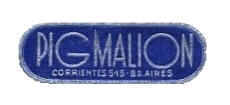
Bookstore Pigmalion - the bookseller's lable photo © Elke Rehder
Publisher János Peter Kramer
Kramer was a bookseller, art dealer and publisher since May 1932. He published
bibliophile books in small editions. In October 1940 he met with Stefan and
Lotte Zweig during a lecture tour in Buenos Aires. Stefan Zweig showed interest
in Kramer's bibliophile editions. In 1948 Kramer opened a bookshop in the
elegant shopping street Calle Florida 960. Later he used the name Galería Kramer
and acted to 1989 with international art.
János Peter Kramer was born in 1904 in Nuremberg and came at the age of 25 years on 6 April 1929 by ship from Hamburg to Buenos Aires. In 1938 he published in Buenos Aires in cooperation with the Phaidon Press in London the art book El Greco and in 1941 the book Lettres d'Amour De La religieuse Portugaise, a bibliophile edition with illustrations by the artist Mariette Lydis.
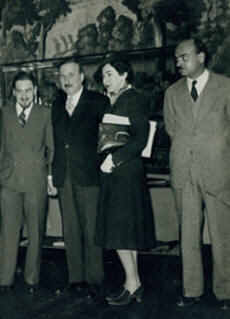
From left to right: J. P. Kramer, Stefan Zweig, Lotte Zweig and Alfredo Cahn
in November 1940 in Buenos Aires
Comparison of the two editions
The first German edition was produced according to the imprint on 7 December
1942 and shortly thereafter published simultaneously by Pigmalión and by Kramer.
Both editions have a special curiosity: The covers are counted in the page
counting as the first page (the cardboard of the paperback by Pigmalión and the
cloth bound hardcover by Kramer). The second page is therefore the inner lid.
The pages (3) and (4) are the blank endpapers. Page (5) is the half-title and was centered printed with the word "SCHACHNOVELLE". Page (6) is empty by the Kramer edition and for the Pigmalión edition were printed a copyright notice in small font type in three lines: "Copyright by VERLAG PIGMALION 1942".
Page (7) is the title page, which is identical but only the names of the publishers are different. At the foot of the title page follows below the stated year MCMXLII the respective publisher information "VERLAG Pigmalión BS. AIRES" resp. "VERLAG JANOS PETER KRAMER, BUENOS AIRES".
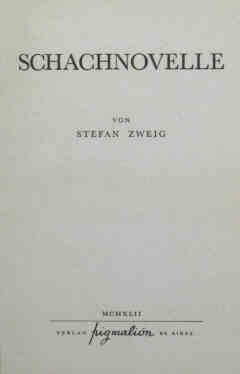
Title page with the publisher's name and date of publication "Verlag
Pigmalión, Buenos Aires" MCMXLII (1942) photo © Elke Rehder
Title page of "Verlag Janos Peter Kramer, Buenos Aires" MCMXLII (1942) photo
© Elke Rehder
On the back of the title page, page (8), right, italics in smaller typeface
following: "Das Original dieses Buches wurde vom Verfasser wenige Stunden vor
dessen Tod seinem Freund und Uebersetzer Alfredo Cahn zugeschickt und erscheint
als Liebhaberdruck in einer nummerierten Auflage. Fünfzig Exemplare in Leinen
gebunden tragen die Nummern I bis L, zweihundertfünfzig Exemplare auf Offset C
Papier gedruckt tragen die Nummern 1 bis 250". Here I translate the German text:
"The original for this book was sent by author a few hours before his death to
his friend and translator Alfredo Cahn and appears as a collector's printing in
a numbered edition. Fifty copies bound in cloth are numbered from I
to L , two hundred and fifty copies printed on offset C paper are numbered
from 1 to 250".
With some distance follows in a larger font size and set in small caps:
"Exemplar No." The number was added later with a stamping machine (three-digit
Arabic for Pigmalión and two digits in Roman for Kramer). The text of the
novella begins on the not numbered page (9). The pagination begins in both
issues with page number 10 and ends with the page number 97.
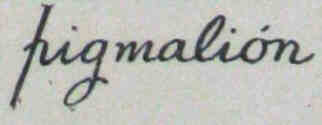
Publisher's mark of Verlag Pigmalión in Buenos Aires photo © Elke Rehder
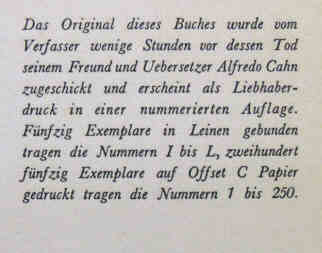
Imprint on the back of the title page (8). The text was set in a grouped
style. The word "zweihundertfünfzig" (two hundred fifty) has no hyphen,
because the seventh text line was too narrow for a hyphen. photo © Elke
Rehder
Typography, typesetting, printing and paper are identical in both editions. The size of the brochure is 19.5 x 13.0 cm. The hardcover by Kramer with the thicker and a bit larger cloth bound cover has the size 20.5 x 13.5 cm. On the front of the last unnumbered leaf the following imprint is set in capital letters in a smaller font size (in both editions) : "Gedruckt und fertiggestellt in den Werkstätten der Compañía Fabril Financiera, Iriarte 2035, Buenos Aires, am 7. December 1942." (Printed and completed in the workshops of the Compañía Fabril Financiera, Iriarte 2035 Buenos Aires, on December 7, 1942).
A special feature is the pagination. The numbers of the counted sites are placed above the text block and are aligned to the left or right side of the text block. There are two different headers for odd- and even-numbered pages. Left pages "STEFAN ZWEIG" and right pages "SCHACHNOVELLE" printed in capital letters.
Imprint on the unnumbered page (99) photo © Elke Rehder
Sample of page 13 with the header and pagination photo © Elke Rehder
Both covers were printed in letterpress printing. For Kramer the title is printed in black on the red brown cloth of the front cover and the author's name is printed on the spine. For Pigmalión the spine of the brochure was too narrow for printing. Therefore the author's name is printed on the front cover above the title. Below the title there is an illustration printed in dark brown color. The illustration shows a stylized chessboard with an overlying branch. The theme chess is symbolized by illustrator with 25 instead of 64 fields. The branch or twig connects to the author's name "Zweig" which is the German word for branch or twig. Presented is here an olive branch (oleae ramusculo). Not only in Judaism the olive tree enjoys high reputation and is worshiped. This pictorial presentation has been placed to worship the author Stefan Zweig. The downward hanging twigs are a sign of mourning, a grief over the sudden and unexpected death of the author.
Stefan Zweig Schachnovelle cover brochure - edition by Librerá Pigmalión in
Buenos Aires 1942 photo © Elke Rehder
Schachnovelle in hardcover cloth binding - edition by János Peter Kramer in
Buenos Aires 1942 photo © Elke Rehder
Not only the limitation to 250 numbered copies but especially these subtle and excellent illustration render the otherwise simple brochure to the by Stefan Zweig desired collector's edition. The illustration is not included in the hardcover edition by Kramer.
Vignette on the cover of the Pigmalión edition Buenos Aires 1942 photo ©
Elke Rehder
The artist of the cover vignette of Pigmalión edition of Schachnovelle was probably Clément Moreau (* March 26, 1903 in Koblenz Germany; † 27 December 1988 in Sirnach, Switzerland), whose real name is Carl Joseph Meffert. He was well acquainted with Stefan Zweig's literary agent and friend Alfredo Cahn. Moreau fled in 1935 from Switzerland to Argentina, where Cahn already worked since 1924 in Buenos Aires. Moreau worked as an illustrator for the Argentinische Tageszeitung, a German foreign daily newspaper founded by Johann Alemann in 1874 who also launched the Pestalozzi-School in Buenos Aires. The linocuts by the artist Clément Moreau enjoyed great popularity and he worked together in friendly cooperation with the literary agent Alfredo Cahn.
Most likely Alfredo Cahn had the artists Clément Moreau invited to produce a suitable cover illustration for the Pigmalión softcover edition. After returning from a journey from Rio de Janeiro in 1942 Alfredo Cahn was in urgend need to publish Stefan Zweig's typescript Schachnovelle in German as soon as possible. Alfredo Cahn with the address of the German bookstore Pigmalión, which was founded in Buenos Aires a few months earlier by the German immigrant Miss Lili Lebach. The organization of this publication was in the hands of Alfredo Cahn. In 1942 Alfredo Cahn was still busy with the translation of Stefan Zweig's book Die Welt von Gestern (The world of yesterday) into Spanish. The first Spanish-language edition of his translation was published in 1942 by Claridad in Buenos Aires with the Spanish title El mundo de ayer. Alfredo Cahn's translation of Schachnovelle was published three years later in 1945 with the Spanish title Una Partida de Ajedrez by the publishing company Espasa-Calpe Argentina. (Una Partida de Ajedrez; Una carta: (Dos Narraciones póstumas) two stories from the estate published in the series Collección Austral, 541). Also in 1945 a Spanish-language translation by Ferenc Oliver Brachfeld (* Budapest 1908; † Quito 1967) was published under the title El Jugador de Ajedrez by the publishing company Victoria in Barcelona (1945). (and under the same title since 1952 by Editorial Juventud in Barcelona translated by J. Rico).
But the artist of the cover illustration could also be Héctor Julio Páride Bernabó, who is better known in the arts under the name Carybé. He was born in Lanús, Buenos Aires province, Argentina, 7 February 1911 and died in Salvador, Bahia, Brazil, 2 October 1997. He was a painter, engraver, draughtsman, illustrator, potter, sculptor, mural painter, researcher, historian and journalist. He settled in Brazil and naturalized as a Brazilian and became a friend of the famous writer Jorge Amado (1912-2001 in Salvador, Bahia).
Some months after the publication of Schachnovelle the owner of the bookstore Pigmalión, Miss Lili Lebach, published in 1943 a book by the author Newton Freitas. The title is Maracatú : motivos típicos y carnavalescos and for this publication the name of the illustrator "CARYBE" is printed in capital letters on the front cover (Thanks to Dr. Roland Jaeger in Hamburg for his helpful information).
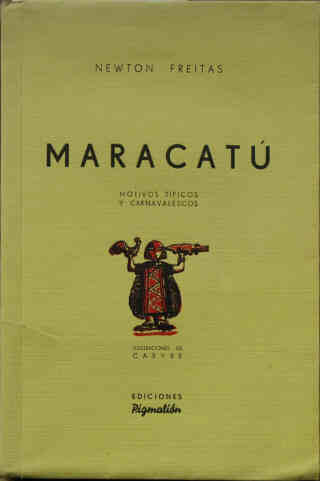
Newton Freitas: Maracatú photo © Elke Rehder
In 1942 Carybé returned from his study trips to other South American countries back to Buenos Aires and worked as an illustrator for the publisher Claridad (Collection Claridad vol. 51); author: Enrique Amorim (1900-1960); title: La carreta (Buenos Aires, 1942). In 1943 Carybé showed his art works in a single exhibition at the Galería Nordiska in a large department store in Buenos Aires.
Announcement and publication of an extract from Schachnovelle in
the German-language daily newspaper Argentinisches Tageblatt in Buenos
Aires
On 20 December 1942 Alfredo Cahn published an extensive excerpt from the
German text of Schachnovelle in the daily newspaper Argentinisches
Tageblatt in Buenos Aires. For the newspaper printing the text was set in
columns by a Linotype machine in hot metal typesetting. For the typesetting in
columns in accordance with the print layout of the newspaper they perhaps used
the proof sheets from the book printing production at Fabril. The excerpt from
the
Schachnovelle is in the newspaper from 20 December 20 1942, page 6, with
the headline Spiel gegen den Schachmeister. The German text from the
novella starts with "Die Mitteilungen meines Freundes verfehlten nicht, meine
besondere Neugier zu erregen." This is a good example for the different diction
between the first German book edition by Pigmalión and Kramer and the
publication in the newspaper: on page 19 of the book edition we find the word
"Neugierde" instead of "Neugier" (both means curiosity). The reason for the
different spelling might be caused by one of the typesetters in the composing
room of the newspaper. He had to rewrite it from the original text on a Linotype
typesetting machine. There are also some more differences between the book
edition and the newspaper publication. The text in the newspaper is similar to
the pages 19-39 of the first German book edition. With the following original
newspaper columns you now have the possibility to compare the text with the book
edition and / or the three different typescripts in the libraries.
Here you will find the text from the newspaper, a click on a small picture will
open a larger size in a new windows and another additional click will expand the
text to 100% for better reading:
Today the Argentinisches Tageblatt has a circulation of 10,000 copies. The newspaper was founded by Johann Alemann in 1874 and is still in family ownership. Today the editors are Juan and Roberto Alemann. The historical archive of the newspaper is in the Bibliothek Ibero-Amerikanischen Instituts Preußischer Kulturbesitz (the library Ibero-American Institute Prussian Cultural Heritage in Berlin). Thanks to Egbert Meissenburg, who first informed me about this rare excerpt from the German first edition of Schachnovelle.
The third typescript was sent to the address of Zweig's publisher Gottfried Bermann in New York City. Gottfried Bermann, later Gottfried Bermann Fischer ( 31 July 1897, Gleiwitz, Silesia – 17 September 1995, Camaiore), was a German publisher and the later owner of the S. Fischer Verlag. In June 1940 he had to move from Stockholm to the United States. In 1943 he published the German edition of Schachnovelle in Stockholm, a book with 117 pages in an edition of 5000 copies. A second edition of 6000 copies was published in 1945. In 1949 followed an illustrated edition of 8000 copies also by Bermann-Fischer. This edition has 183 pages and illustrations by the Austrian artist Hans Fronius.
This original carbon copy of the typescript can be found in the Lilly Library, Indiana University, Bloomington, in the state of Indiana. This carbon paper typescript from 21 February 1942 has 62 numbered pages plus a double counted page plus the unnumbered title page. That is a total of 64 single-sided sheets according to Egbert Meissenburg / 63 pages according to Dr. Randolph J. Klawiter.
The fourth typescript was sent to the address of Stefan Zweig's friend and editor Benjamin W. Huebsch (known as B. W. Huebsch) in New York City. This original carbon copy of the typescript can be found in the Library of Congress in Washington, B. W. Huebsch collection. Papers / Miscelany / Container Box 41 / Literary manuscripts. Huebsch was working as a manager for the publishing company Viking Press. He translated the German text of Schachnovelle and created the English title The Royal Game. The English text was published together with some color illustrations by Dillwyn Thomas in the US magazine Woman's Home Companion, Volume LXXI, No. 3, March; Crowell Publishing Co., 1944, 22-23, 96-98, 100,102, 106-111, 114-115 pages. The full text starts with "The big liner ..." on page 22 and ends with "a great deal of talent for an amateur" on page 115. The name of the translator B. W. Huebsch is not mentioned in the magazine. The full text of The Royal Game was published one month earlier than the book edition. The magazine is not mentioned on the website of the Stefan Zweig Bibliography compiled by Dr. Randolph J. Klawiter but it is mentioned in the book by Randolph J. Klawiter: Stefan Zweig. An International Bibliography. Ariadne Press, Riverside 1991, number F 293. Thanks to Egbert Meissenburg for his kind information about the publication in this magazine.
Here is the offer from my antiquarian bookshop Versandantiquariat Elke Rehder
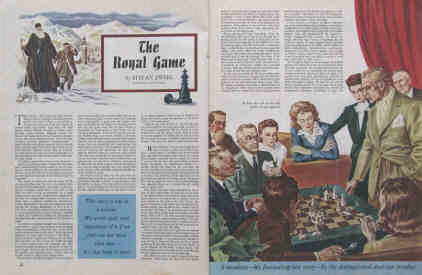 copyright restrictions, publishing only for this offer for sale
copyright restrictions, publishing only for this offer for sale
It is the complete magazine with 132 pages with many illustrations. The
condition is nearly good but the paper has a strong odor. There are some folds
and tears on edges. Some pages with stronger foxing or damp-stained. Offered by
my antiquarian bookshop
ARTIKEL-Nr. A008402 Preis 140,00 € inkl. MwSt, inkl. Versand. Unser
Liefergebiet ist Deutschland. Lieferzeit 3-5 Tage. Zahlungsarten: PayPal /
Überweisung.
In this magazine is also a smaller third illustration on page 96
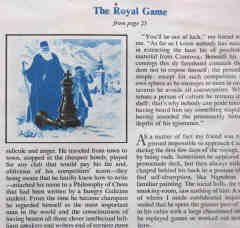 copyright restrictions, publishing only for this offer for sale
copyright restrictions, publishing only for this offer for sale
The first American book edition was published in April 1944 by the
publishing company Viking Press
in New York. In 1944 there was also an Armed Services Edition published
with copyright by the Viking Press. The first British book edition was
published by
Cassell and Company Ltd., London / Toronto / Melbourne / Sydney: (no year
stated) [February 1945; thanks to Manfred Mittelbach book collection from Nov.
26, 2018] . These editions include the additional stories Amok and
Letter from an Unknown Woman, which were taken from the 1922 published
anthology Amok, Novellen einer Leidenschaft by the German publishing
house Insel Verlag in Leipzig and had been translated by Cedar and Eden
Paul, the very prolific translators of Stefan Zweig's works.
This page was first uploaded: January 3, 2015.
Autor: Elke Rehder. Der Text in englischer Sprache ist eine erweiterte Fassung des Aufsatzes "Anmerkungen zur Schachnovelle", erschienen in der Zeitschrift "Aus dem Antiquariat". Frankfurt a. M., Heft 6, 2014. S. 273-279. ISSN 0343-186X
Elke Rehder
Blumenstr. 19
22885 Barsbüttel
Germany
USt-IdNr. DE172804871
Tel: +49 (0) 40 710 88 11 oder E-Mail: ![]()
Bestellen können Sie telefonisch, schriftlich oder per E-Mail.
|
|